Go WebSocket unit testing can verify the correctness and robustness of the WebSocket server. Install Ginkgo and Gomega testing frameworks. Create and start a WebSocket server. Writing unit tests: Establishing a WebSocket connection. Send and receive messages. Verify response. Run tests to verify server functionality.

Go WebSocket Unit Testing Guide
WebSocket is a network that establishes a two-way, persistent connection between a client and a server protocol. In Go, [gorilla/websocket](https://godoc.org/github.com/gorilla/websocket) is a popular library for creating and handling WebSocket connections. Unit testing is essential when writing a WebSocket server because it verifies the correctness and robustness of the code. This article will provide a step-by-step guide to unit testing Go WebSocket using Ginkgo and Gomega, with practical examples.
Step 1: Install the testing framework
Use Go Modules to manage dependencies and install Ginkgo and Gomega through the following commands:
go get -u github.com/onsi/ginkgo/v2 go get -u github.com/onsi/gomega
Step 2: Create a WebSocket server
Create a new Go module and write a simple WebSocket server, for example:
package main
import (
"github.com/gorilla/websocket"
"log"
"net/http"
)
func main() {
http.HandleFunc("/", func(w http.ResponseWriter, r *http.Request) {
conn, err := websocket.Upgrade(w, r, nil, 1024, 1024)
if err != nil {
log.Println(err)
http.Error(w, "Internal Server Error", http.StatusInternalServerError)
return
}
log.Printf("WebSocket connection established")
// Handle incoming messages and send responses...
})
log.Println("Listening on port 8080")
if err := http.ListenAndServe(":8080", nil); err != nil {
log.Println(err)
}
}Step 3: Write unit tests
Use Ginkgo and Gomega frameworks to write unit tests, for example:
package main_test
import (
"bytes"
"net/http"
"net/http/httptest"
"testing"
"github.com/gorilla/websocket"
"github.com/onsi/ginkgo/v2"
"github.com/onsi/gomega"
)
var _ = ginkgo.Describe("WebSocket Server", func() {
var (
ts *httptest.Server
clientConn *websocket.Conn
)
ginkgo.BeforeEach(func() {
ts = httptest.NewServer(http.HandlerFunc(wsHandler))
var err error
clientConn, _, err = websocket.DefaultDialer.Dial(ts.URL, nil)
gomega.Expect(err).To(gomega.BeNil())
})
ginkgo.AfterEach(func() {
ts.Close()
clientConn.Close()
})
ginkgo.It("should establish a WebSocket connection", func() {
gomega.Expect(clientConn).NotTo(gomega.BeNil())
})
ginkgo.It("should send and receive messages", func() {
// Send a message to the server
err := clientConn.WriteMessage(websocket.TextMessage, []byte("Hello WebSocket!"))
gomega.Expect(err).To(gomega.BeNil())
// Read the response from the server
_, msg, err := clientConn.ReadMessage()
gomega.Expect(err).To(gomega.BeNil())
// Verify the response
gomega.Expect(string(msg)).To(gomega.Equal("Hello Client!"))
})
})Practical case
This example shows how to use Ginkgo and Gomega testing The basic functionality of a WebSocket server to establish a connection and send/receive messages. You can extend these tests to verify other use cases, such as authentication, connection limits, or error handling.
Note:
- Make sure to start the WebSocket server before running the test.
- Adjust the WebSocket URL and port to match actual server settings.
The above is the detailed content of How to unit test Go WebSocket?. For more information, please follow other related articles on the PHP Chinese website!
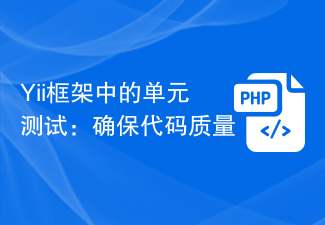 Yii框架中的单元测试:确保代码质量Jun 21, 2023 am 10:57 AM
Yii框架中的单元测试:确保代码质量Jun 21, 2023 am 10:57 AM随着软件开发的日益复杂化,确保代码质量变得越来越重要。在Yii框架中,单元测试是一种非常强大的工具,可以确保代码的正确性和稳定性。在本文中,我们将深入探讨Yii框架中的单元测试,并介绍如何使用Yii框架进行单元测试。什么是单元测试?单元测试是一种软件测试方法,通常用于测试一个模块、函数或方法的正确性。单元测试通常由开发人员编写,旨在确保代码的正确性和稳定性。
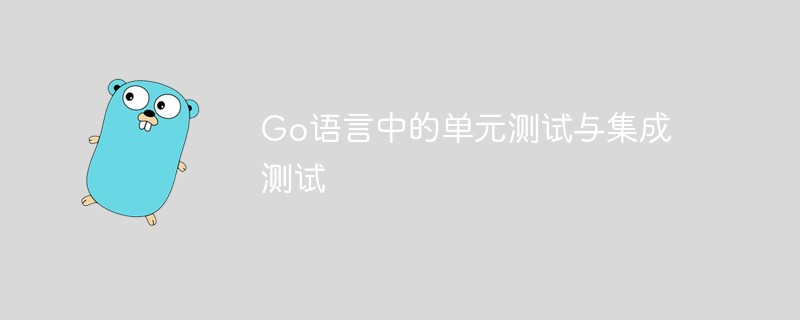 Go语言中的单元测试与集成测试Jun 02, 2023 am 10:40 AM
Go语言中的单元测试与集成测试Jun 02, 2023 am 10:40 AM随着软件开发变得越来越复杂,测试也变得越来越重要。在实际开发中,有两种常见的测试方法:单元测试和集成测试。在这篇文章中,我们将聚焦于Go语言中的这两种测试方法。一、单元测试单元测试是一个独立的测试单元,用于测试程序中的逻辑单元,比如函数、方法、类等。这些测试通常由开发人员自己编写,用于验证程序的各个单元是否按照预定的规则工作。在Go语言中,我们可以使用标准库
 用ThinkPHP6实现单元测试Jun 20, 2023 pm 11:52 PM
用ThinkPHP6实现单元测试Jun 20, 2023 pm 11:52 PMThinkPHP是一款非常流行的PHP开发框架,它具有开发效率高、学习成本低、灵活性强等优点。对于一个优秀的开发团队来说,单元测试是保证代码质量的一种必要手段。本篇文章将介绍如何使用ThinkPHP6框架进行单元测试,以提高项目的稳定性和开发效率。一、什么是单元测试?单元测试是指对软件中的最小可测试单元进行检查和验证的一种测试方法。在PHP开发中,单元测试可
 php如何使用PHPUnit和Mockery进行单元测试?May 31, 2023 pm 04:10 PM
php如何使用PHPUnit和Mockery进行单元测试?May 31, 2023 pm 04:10 PM在PHP项目开发中,单元测试是一项很重要的任务。PHPUnit和Mockery是两个相当流行的PHP单元测试框架,其中PHPUnit是一个被广泛使用的单元测试工具,而Mockery则是一个专注于提供统一而简洁的API以创建和管理对象Mock的对象模拟工具。通过使用PHPUnit和Mockery,开发人员可以快速高效地进行单元测试,以确保代码库的正确性和稳定性
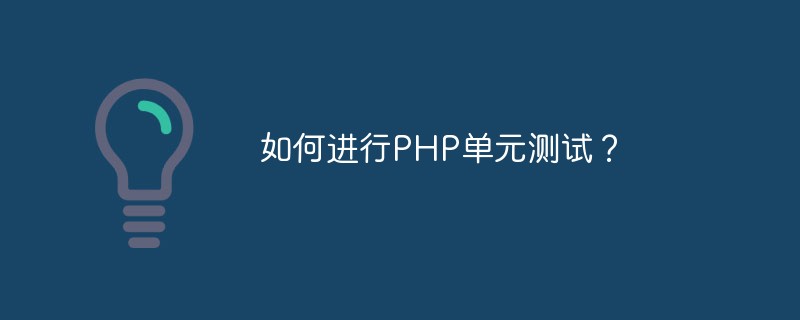 如何进行PHP单元测试?May 12, 2023 am 08:28 AM
如何进行PHP单元测试?May 12, 2023 am 08:28 AM在Web开发中,PHP是一种流行的语言,因此对于任何人来说,对PHP进行单元测试是一个必须掌握的技能。本文将介绍什么是PHP单元测试以及如何进行PHP单元测试。一、什么是PHP单元测试?PHP单元测试是指测试一个PHP应用程序的最小组成部分,也称为代码单元。这些代码单元可以是方法、类或一组类。PHP单元测试旨在确认每个代码单元都能按预期工作,并且能否正确地与
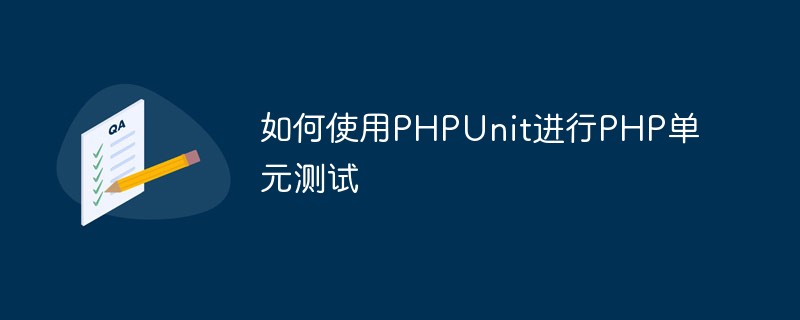 如何使用PHPUnit进行PHP单元测试May 12, 2023 am 08:13 AM
如何使用PHPUnit进行PHP单元测试May 12, 2023 am 08:13 AM随着软件开发行业的发展,测试逐渐成为了不可或缺的一部分。而单元测试作为软件测试中最基础的一环,不仅能够提高代码质量,还能够加快开发者开发和维护代码的速度。在PHP领域,PHPUnit是一个非常流行的单元测试框架,它提供了各种功能来帮助我们编写高质量的测试用例。在本文中,我们将介绍如何使用PHPUnit进行PHP单元测试。安装PHPUnit在使用PHPUnit
 Go语言中的单元测试和集成测试:最佳实践Jun 17, 2023 pm 04:15 PM
Go语言中的单元测试和集成测试:最佳实践Jun 17, 2023 pm 04:15 PM在软件开发中,测试是一个极其重要的环节。测试不仅可以帮助开发人员找出代码中的错误,还可以提高代码的质量和可维护性。在Go语言中,测试是使用GoTest工具完成的。GoTest支持单元测试和集成测试两种测试方式。在本文中,我们将介绍Go语言中单元测试和集成测试的最佳实践。单元测试单元测试是指对程序中的最小可测试单元进行测试。在Go语言中,一个函数或方法就是
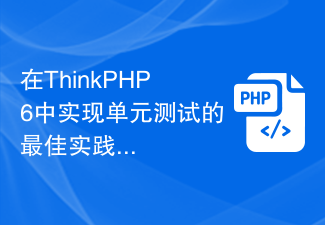 在ThinkPHP6中实现单元测试的最佳实践Jun 21, 2023 am 10:31 AM
在ThinkPHP6中实现单元测试的最佳实践Jun 21, 2023 am 10:31 AM在ThinkPHP6中实现单元测试的最佳实践随着现代软件开发中的快速迭代和高效交付的要求,单元测试已经成为一种不可或缺的自动化测试方法。在PHP语言中,单元测试框架的流行使得开发者不必再手动测试每个函数和方法,而是可以编写测试用例自动化地检查代码的正确性。在ThinkPHP6中,PHPUnit单元测试框架被默认集成进了框架内部,并且具有相当完备的功能和优秀的


Hot AI Tools

Undresser.AI Undress
AI-powered app for creating realistic nude photos

AI Clothes Remover
Online AI tool for removing clothes from photos.

Undress AI Tool
Undress images for free

Clothoff.io
AI clothes remover

AI Hentai Generator
Generate AI Hentai for free.

Hot Article

Hot Tools

MantisBT
Mantis is an easy-to-deploy web-based defect tracking tool designed to aid in product defect tracking. It requires PHP, MySQL and a web server. Check out our demo and hosting services.

Atom editor mac version download
The most popular open source editor

Dreamweaver Mac version
Visual web development tools

Notepad++7.3.1
Easy-to-use and free code editor

SublimeText3 English version
Recommended: Win version, supports code prompts!






